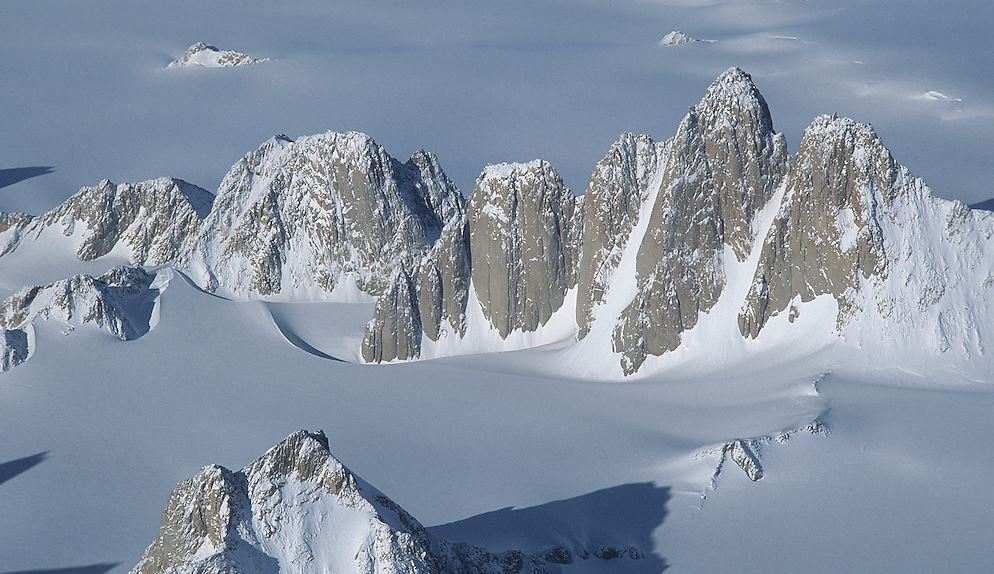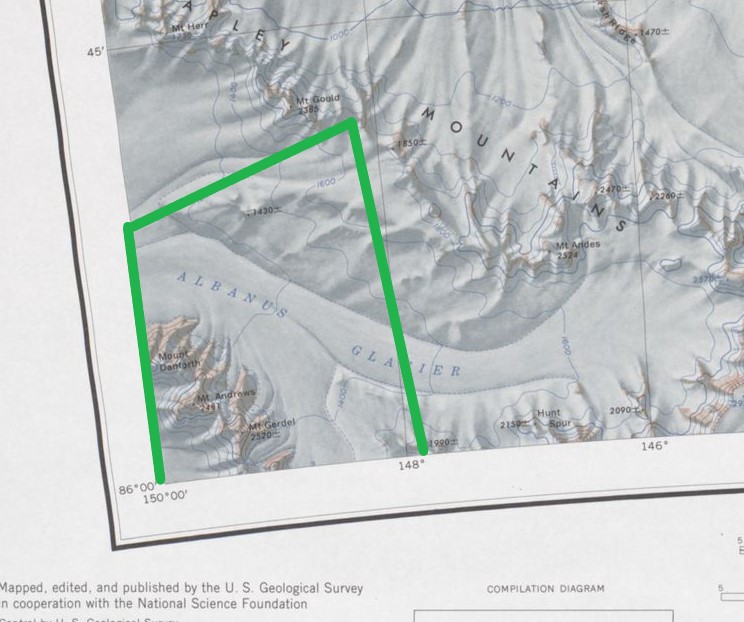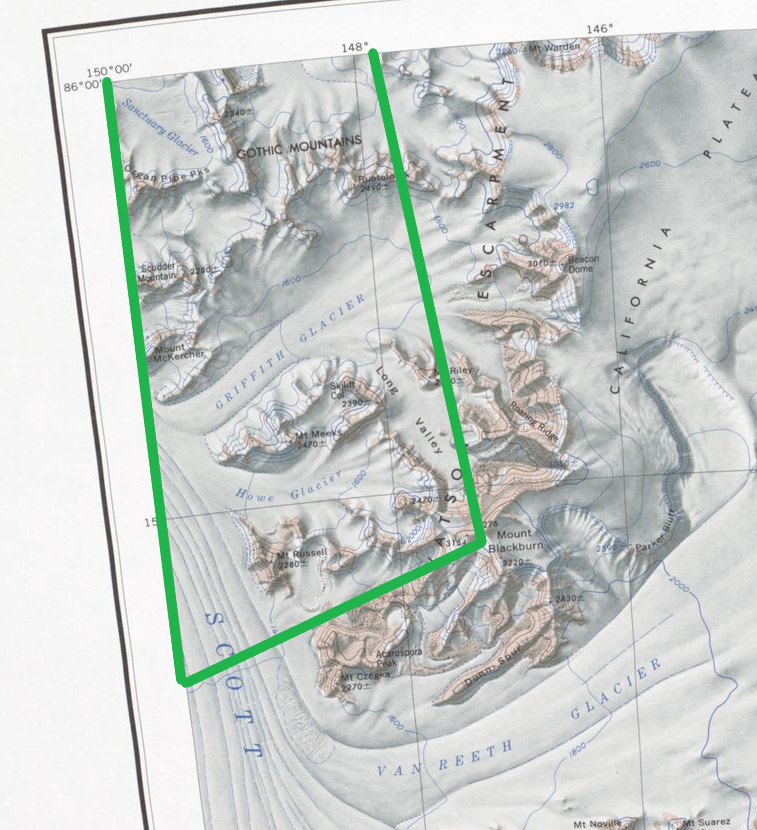Gothic National Monument
Gothic National Monument (86°00′S 150°00′W) is protected area of Westarctica created to preserve the pristine landscape of the Gothic Mountains in the greater Queen Maud Mountains. It was created via Royal Decree on 20 April 2005 by Grand Duke Travis. It falls under the oversight of the Westarctican Parks Service.
History
The mountains were first visited in December 1934 by the Byrd Antarctic Expedition geological party led by Quin Blackburn. The name was proposed by Edmund Stump, leader of a U.S. Antarctic Research Program (USARP) - Arizona State University geological party which made investigations here in the 1980-81 season. The mountains are composed of granites which have weathered to produce a series of spires and peaks reminiscent of a Gothic cathedral.
The Gothics are among the more physically and geographically distinct ranges in the nation. As part of the Transantarctic Mountains near the south pole, the Gothic Mountains, and most notably the Organ Pipes are some of the most photographed and thoroughly explored in Westarctica. Most notably in published photographic collections by Stump.
The Gothic Mountains were on the January 2024 list of ten sites that should be considered for eventual protection as a national park of Westarctica. They were on the list of five recommended areas to protect made by Jordan Farmer to Grand Duke Travis in March of 2025. On 20 April 2025, Grand Duke Travis declared the Gothic Mountains a national monument under the oversight of the Westarctican Parks Service. Gothic National Monument has been identified as a leading candidate for elevation to the status of national park.
Conservans Protectorem
Those nobles whose titles were named for features within the memorial when it was established were afforded the additional honorific Conservans Protectorem to use in conjunction with said title. Gothic Mountains National Monument granted that honorific to the following:
- Duke of Albanus
- Duke of the Gothic Mountains
- Count of Meeks
Features
While not all of the Gothic Mountains fall within Westarctica's borders, the majority do. The monument protects the entirety of the Westarctican Gothic range, as well as a portion of the nearby Albanus Glacier, the entirety of the Howe and Griffith glaciers, Long Valley, and Mount Russell.
Key locations
- Albanus Glacier (85°52′S 149°0′W), also known as Phillips Glacier, is a 25-nautical-mile (46 km; 29 mi) long glacier flowing west along the south side of the Tapley Mountains to enter Scott Glacier just north of Mount Zanuck. Richard E. Byrd named it in honor of Albanus Phillips, Jr., president of Phillips Packing in Cambridge, Maryland, a patron of, and supplier of provisions to, his Antarctic expeditions of 1928–30 and 1933–35.
- Griffith Glacier (86°11′S 149°24′W) is a tributary glacier draining westward from the California Plateau and Watson Escarpment to enter Scott Glacier between Mount McKercher and Mount Meeks. Mapped by USGS from surveys and USN air photos, 1960-63. Named by US-ACAN for Lt. Cdr. Philip G. Griffith, aircraft commander on photographic flights during Operation Deep Freeze 1966 and 1967.
- Grizzly Peak (86°00′S 150°00′W) is a peak rising to 2,200 m on the southwest flank of Mount Zanuck. The feature was visited in December 1934 by the Byrd Antarctic Expedition geological party and was included in "Darryl Zanuck Mountain." The granite of this peak is highly jointed and fairly bristles with small spires, suggestive of the coat of a grizzly bear.
- Howe Glacier (86°14′S 149°12′W) is a short tributary glacier draining west into Scott Glacier immediately north of Mount Russell, in the Queen Maud Mountains. Mapped by USGS from surveys and USN air photos, 1960-63. Named by US-ACAN for Robert C. Howe of USN Squadron VX-6, photographer on Operation Deep Freeze 1966 and 1967.
- Long Valley (86°13′S 147°48′W) is an ice-filled valley, 6 nautical miles (11 km; 6.9 mi) long, extending from Mount Blackburn northwestward to Griffith Glacier. Named by US-ACAN for Walter H. Long, Jr., of United States Navy Squadron VX-6, photographer on Operation Deep Freeze 1966 and 1967.
- Mount Meeks (86°13′S 148°51′W) is a mountain, 2,470 metres (8,100 ft) high, surmounting the rocky divide between Griffith Glacier and Howe Glacier. Named by US-ACAN for Lt. Harman T. Meeks of United States Navy Squadron VX-6, navigator on aircraft during Operation Deep Freeze 1966 and 1967.
- Mount Russell (86°17′S 149°08′W) is a mountain, 2,280 metres (7,480 ft) high, standing on the east flank of Scott Glacier just south of the mouth of Howe Glacier. Discovered in December 1934 by the geological party of the ByrdAE, 1933-35, and named for Richard S. Russell, Jr., one of the members of that party, and his father, Richard S. Russell, Sr., a supporter of the Byrd Antarctic expeditions.
- Organ Pipe Peaks (86°03′S 150°00′W) is a row of aiguille type rock peaks, 7 miles (11 km) long, standing just north of Mount Harkness. Discovered by the geological party of the Byrd Antarctic Expedition, 1933–35, who gave the descriptive name.
- Sanctuary Glacier (86°00′S 150°25′W) is a glacier almost completely encircled by the Gothic Mountains. It drains west between Outlook Peak and Organ Pipe Peaks into Scott Glacier. Mapped by USGS from surveys and USN aerial photographs, 1960-64. The descriptive name was proposed by Edmund Stump, leader of a USARP-Arizona State University geological party which established a base camp on the glacier in January 1981.
- Scott Glacier is a major glacier, 120 miles (190 km) long, that drains the East Antarctic Ice Sheet through the Queen Maud Mountains to the Ross Ice Shelf. The Scott Glacier is one of a series of major glaciers flowing across the Transantarctic Mountains, with the Amundsen Glacier to the west and the Leverett and Reedy Glaciers to the east. Only a small portion of the glacier falls within the monument's borders.
- Skilift Col (86°11′S 148°36′W) is a col in the mountain wall between the Griffith Glacier and Howe Glacier, on the west side of Watson Escarpment. The col is 2 nautical miles (3.7 km; 2.3 mi) northeast of Mount Meeks and provides a shortcut to field parties. So named by NZGSAE, 1969-70, because some members of the party used a motor toboggan here in a similar way to a ski-lift.


